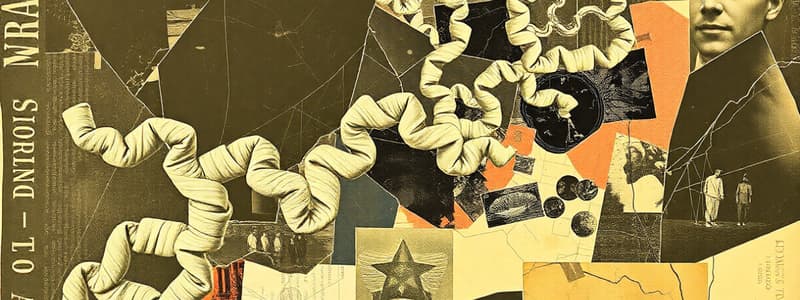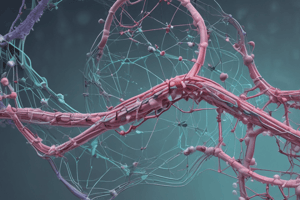Podcast
Questions and Answers
What is the meaning of the term 'collagen' in Greek?
What is the meaning of the term 'collagen' in Greek?
- Fiber processor
- Strength producer
- Glue producer (correct)
- Bone maker
What is the typical structure of collagen molecules?
What is the typical structure of collagen molecules?
- A short, coiled structure
- A long, flexible chain
- A rope-like triple helix (correct)
- A branched polymer
What percentage of the organic matrix of bone does collagen comprise?
What percentage of the organic matrix of bone does collagen comprise?
- 40%
- 90% (correct)
- 70%
- 50%
Which amino acid is most abundant in collagen?
Which amino acid is most abundant in collagen?
How many polypeptide chains typically wind around each other in a collagen molecule?
How many polypeptide chains typically wind around each other in a collagen molecule?
Which of the following tissues does NOT primarily contain collagen?
Which of the following tissues does NOT primarily contain collagen?
What is a role of collagen in developing tissue?
What is a role of collagen in developing tissue?
What type of fibers does collagen form that have high tensile strength?
What type of fibers does collagen form that have high tensile strength?
What is the primary characteristic of secondary structure in proteins?
What is the primary characteristic of secondary structure in proteins?
Which type of interactions primarily determine the tertiary structure of a protein?
Which type of interactions primarily determine the tertiary structure of a protein?
What defines the quaternary structure of a protein?
What defines the quaternary structure of a protein?
Which of the following is NOT a type of structural protein?
Which of the following is NOT a type of structural protein?
How do hydrophobic interactions affect protein structure?
How do hydrophobic interactions affect protein structure?
What role do disulfide bridges play in protein structure?
What role do disulfide bridges play in protein structure?
Which type of bonding primarily occurs in the primary structure of a protein?
Which type of bonding primarily occurs in the primary structure of a protein?
Which of the following best describes the concept of 'whole molecule folding'?
Which of the following best describes the concept of 'whole molecule folding'?
Which amino acid is the precursor of hydroxylysine?
Which amino acid is the precursor of hydroxylysine?
What enzyme converts proline residues into hydroxyproline?
What enzyme converts proline residues into hydroxyproline?
What is required by prolyl hydroxylase to maintain its active state?
What is required by prolyl hydroxylase to maintain its active state?
Which sugars are commonly attached to hydroxylysine residues during glycosylation?
Which sugars are commonly attached to hydroxylysine residues during glycosylation?
What is the name of the larger precursors injected into the endoplasmic reticulum during collagen synthesis?
What is the name of the larger precursors injected into the endoplasmic reticulum during collagen synthesis?
Which type of collagen is primarily found in skin, tendon, bone, and cartilage?
Which type of collagen is primarily found in skin, tendon, bone, and cartilage?
What forms when three pro-α chains combine?
What forms when three pro-α chains combine?
What type of enzyme is collagenase?
What type of enzyme is collagenase?
Which type of collagen is associated with the basement membrane?
Which type of collagen is associated with the basement membrane?
Which organism is known to secrete collagenase that causes gas gangrene?
Which organism is known to secrete collagenase that causes gas gangrene?
What characteristic does glycine contribute to the collagen structure?
What characteristic does glycine contribute to the collagen structure?
Which of the following is a characteristic of fibril-forming collagens?
Which of the following is a characteristic of fibril-forming collagens?
What is the primary structure of individual -keratin molecules in hair?
What is the primary structure of individual -keratin molecules in hair?
What role does proline play in collagen synthesis?
What role does proline play in collagen synthesis?
How many protofibrils combine to form a microfibril in hair structure?
How many protofibrils combine to form a microfibril in hair structure?
What are hydroxyproline and hydroxylysine derived from?
What are hydroxyproline and hydroxylysine derived from?
Which type of collagen is mainly found in cartilage and the vitreous humor?
Which type of collagen is mainly found in cartilage and the vitreous humor?
What structural unit is a bundle of hundreds of microfibrils referred to as?
What structural unit is a bundle of hundreds of microfibrils referred to as?
What aspect differentiates network-forming collagens from fibril-forming collagens?
What aspect differentiates network-forming collagens from fibril-forming collagens?
What process is involved in creating a 'permanent wave' in human hair?
What process is involved in creating a 'permanent wave' in human hair?
What introduces cross-links that harden -keratin in various tissues?
What introduces cross-links that harden -keratin in various tissues?
What component is mixed with dead and living cells to create a complete strand of hair?
What component is mixed with dead and living cells to create a complete strand of hair?
Which of the following statements about structural proteins is true?
Which of the following statements about structural proteins is true?
Which characteristic describes the twisted cables of hardened hair?
Which characteristic describes the twisted cables of hardened hair?
Flashcards are hidden until you start studying
Study Notes
Protein Structure
- Secondary protein structure represents the initial folding of the primary structure along its chain. This "local folding" involves interactions between adjacent amino acids, specifically hydrogen bonds between R groups.
- Tertiary protein structure is the three-dimensional folding of the secondary structure. This "whole molecule folding" is determined by interactions between R groups, including hydrophobic interactions, disulfide bridges, and hydrogen and ionic bonds.
- Quaternary protein structure involves the joining of two or more polypeptide chains, which then become a functional protein. Hydrophobic interactions are the driving force for this level of protein structure.
- The structure of proteins is influenced by the nature of the amino acid side chains, which can be either hydrophobic or hydrophilic and dictate how the protein folds to minimize energy and maximize stability.
Structural Proteins
- Structural proteins provide support to major structures such as bones, skin, cartilage, hair, and muscles.
- Collagen, elastin, and keratin are examples of such proteins.
Collagen
- Collagen is the most abundant protein in mammals, making up about a quarter of total body weight.
- It is a long, rigid molecule composed of three polypeptide chains (α chains) wound around each other in a triple helix.
- Collagen serves as a major fibrous element in several tissues, including skin, bone, tendons, cartilage, blood vessels, and teeth.
- The majority of the organic matrix of the bone is composed of collagen.
- In addition to its structural role, collagen functions as a directive element in developing tissues.
- Collagen fibers have high tensile strength.
Collagen Structure
- The most abundant protein in the body, comprised of a triple helix.
- Each polypeptide chain contains approximately 1000 amino acids.
- Glycine, proline, hydroxyproline, and lysine are the most abundant amino acids in collagen.
Types of Collagen
- There are various types of collagen with different compositions that give rise to structural components with slightly differing properties.
- Type I collagen is found in skin, tendons, bone, and cartilage.
- Type II collagen is found in cartilage and vitreous humor.
- Type III collagen is found in fetal skin, the cardiovascular system, and lung vessels.
- Type IV collagen is found in the basement membrane.
Collagen Synthesis
- Individual collagen polypeptide chains are synthesized on membrane-bound ribosomes and passed into the lumen of the endoplasmic reticulum (ER).
- Precursors called pro-α chains are hydroxylated and glycosylated within the ER lumen.
- These pro-α chains then associate to form procollagen, a triple-stranded helical molecule.
Collagenases
- Collagenases are enzymes that break down collagen by cleaving peptide bonds in its characteristic helical regions.
- The collagenase secreted by Clostridium histolyticum is a potent collagenolytic enzyme that can split collagen at over 200 sites.
⍺-Keratins
- ⍺-keratin molecules are composed of long sequences that are entirely ⍺-helical.
- Pairs of these helices intertwine and further twist together to form a 4-molecule protofibril.
- Eight protofibrils assemble into a microfibril, which is the basis of hair structure.
- Microfibrils combine and are bound together with cells to create the final strand of hair.
- The introduction of disulfide cross-links within the different levels of fiber structure hardens ⍺-keratin, making it stronger and more rigid.
Summary
- Structural proteins are widely distributed within the body, supporting various tissues.
- Mutations in genes that control the synthesis of these proteins can lead to serious health issues.
Studying That Suits You
Use AI to generate personalized quizzes and flashcards to suit your learning preferences.





